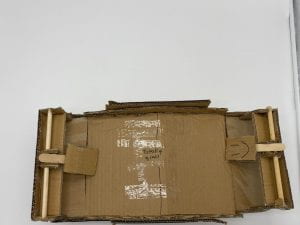Link to contact sheet of selected works: Andreas Gursky selected works (This contact sheet includes image citations.)

Photo 1: Politik II
In this image, Gursky depicts thirteen politicians, all engaging in discussion. All the politicians are positioned in the foreground at the bottom of the photo, with a piece of art (Five Past Eleven) by Ed Ruscha taking up nearly the rest. This photo has an ambivalent tone since the background (the wall) is black, but the artwork is a lot brighter, establishing contrast. The background is also fully in black and white, which establishes a contrast in color against the colorfully dressed politicians. In the background above the politicians is a large levitating piece of white bamboo. Bamboo symbolizes strength, resilience and longevity, which can all be beneficial characteristics for a politician or public speaker. The piece of bamboo also intersects the line created by the clock’s hand, neutralizing it and denying it the ability to be a prominent subject and forms an X above the clock displayed in the artwork, which can symbolize running out of time. The thirteen politicians pictured also mirror the biblical scene “The Last Supper,” but the politician equivalents of prominent characters such as Jesus and Judas are not given. This is a good way of representing how political betrayal isn’t rare and how many politicians make grand remarks and promises like Jesus when giving his disciples wine and bread; however, unlike Jesus, politicians often don’t deliver on their grand comments and promises.

Photo 2: Rhine II
This is a straightforward image of a river surrounded by grassy banks, with a sidewalk towards the bottom of the image. This image is almost entirely made up of straight horizontal lines (grass, sidewalk, river). The sky takes up the top half of the image, and the land occupies the bottom half. Though this image is straightforward, I find it to be an excellent abstraction of rivers since what one most likely pictures when asked to think about a river would be a stretch of blue or light gray water flowing between two green banks. This image also symbolizes finding order in the chaos since rivers typically have lots of turns and bends but this image features a perfectly straight stretch of river.

Photo 4: New York, Mercantile Exchange
The New York Mercantile Exchange (NYMEX) is a commodities futures market in Manhattan. It started when a group of dairy merchants in the area created the Butter and Cheese Exchange of New York in 1872, and after more products were introduced to the exchange, it became the New York Mercantile Exchange in 1882. Today, NYMEX exchanges mostly energy-related commodities such as coal, natural gas, propane, and uranium. This image shows a scene in what is presumably a trading area. There is no clear subject, but the image is darker at the left and right sides. The image also vaguely follows the rule of thirds (the black screen with multicolored text takes up about a third of the image). It also looks like the shutter speed was turned down slightly when taking this photo, resulting in a subtle but noticeable motion blur among the people in the room. This is a good abstraction since it really captures the energy of hundreds of people discussing the exchange of such valuable commodities – buzzing back and forth in multicolored suits, white papers littering the dark cyan floor. It’s a fantastic way of capturing a key area that tourists may overlook in the city that never sleeps.

Photo 7: Las Vegas
This image shows what appears to be a piece of artwork comprised of a wall with a pattern of short golden metal rods on it. There is no clear subject in the photo, but I think it still serves as a symbolic abstraction of the city in its title. When I (and I’m sure many others) think of Las Vegas, the first thing I think about is gambling. “The Strip”, which is probably the most iconic road there, is dotted with casinos on both sides. Gambling activates the reward system in the brain, which makes it highly addicting. Inside a casino, you can probably see people playing slot machines over and over, hoping that the odds will be more in their favor this time than last time. They all follow a pattern, just like the metal tubes in the artwork in this picture. And, just like the image’s pattern, this cycle will end, but definitely not as pleasantly as depicted in the image.

Other citations:
“Bible Gateway Passage: Matthew 26:17-30 – New International Version.” Bible Gateway, 2019, www.biblegateway.com/passage/?search=Matthew%2026%3A17-30&version=NIV. Accessed 18 Sept. 2024.
Wikipedia Contributors. “New York Mercantile Exchange.” Wikipedia, Wikimedia Foundation, 13 June 2024, en.wikipedia.org/wiki/New_York_Mercantile_Exchange. Accessed 18 Sept. 2024.
“The Uncontrollable Urge to Keep Gambling despite the Damage-Compulsive Gambling – Symptoms & Causes – Mayo Clinic.” Mayo Clinic, 2022, www.mayoclinic.org/diseases-conditions/compulsive-gambling/symptoms-causes/syc-20355178. Accessed 18 Sept. 2024.
 Emma, on the other hand, said that she’d just sleep through the end of the world. It’s a really simple answer but I think it still turned out great. Rather than presenting a diptych or triptych, I think a singular photo would work better since emma_4 has the best angle, lighting and pose. For this photo, I decided to apply a black-and-white filter to it.
Emma, on the other hand, said that she’d just sleep through the end of the world. It’s a really simple answer but I think it still turned out great. Rather than presenting a diptych or triptych, I think a singular photo would work better since emma_4 has the best angle, lighting and pose. For this photo, I decided to apply a black-and-white filter to it.
 Photos featured are by Ernst Haas: https://ernst-haas.com/bw-portraits/
Photos featured are by Ernst Haas: https://ernst-haas.com/bw-portraits/











